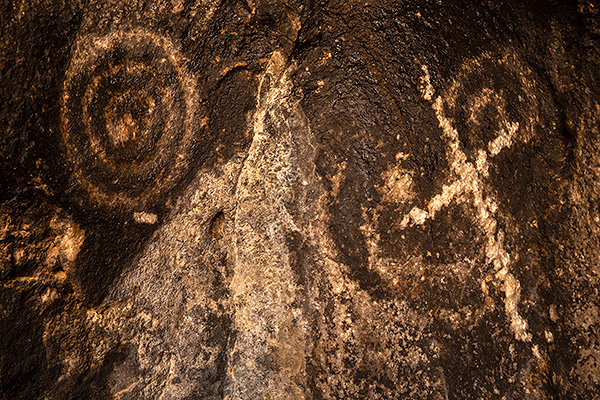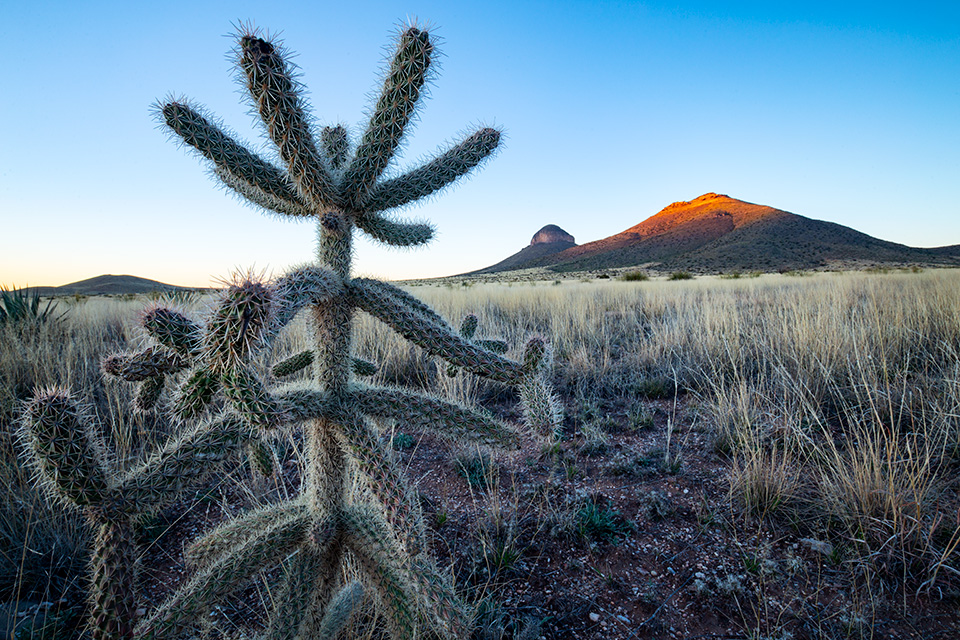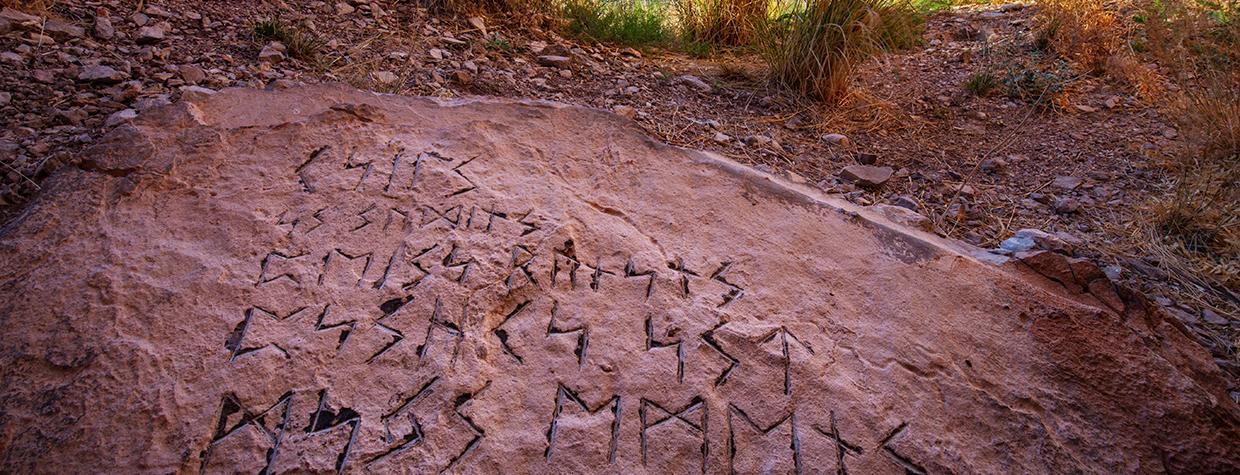In the high-desert grasslands of South-eastern Arizona, a fertile wine country gives way to a small range of low-coned mountains near the tiny community of Elgin. It is here, in the unpretentious Mustang Mountains, that a mystery spurred a trans-Atlantic quest to solve it.
The wind for some time had carried murmurs of a peculiar stone that lay at the opening of a small cave in the mountains east of Sonoita, but few had set eyes on it. That changed after two rock climbers stumbled on it and alerted a national television show to the stone, which was inscribed with obscure markings. Producers of the History channel’s America Unearthed series visited the site to investigate and, in December 2012, aired an episode titled Medieval Desert Mystery. Its conclusion: The stone was a grave marker, carved in runes that memorialized a 12th century English explorer.
The idea that a stone inscribed in runes, or letters, from the Middle Ages rested in an Arizona mountain range didn’t sit well with Ward Sherwood, an avid hiker who lives in Sierra Vista. “I just didn’t believe that there were Englishmen over here before Columbus,” he says.
Sherwood shared his skepticism with fellow hikers Marianne and Jim Adams. “He was as skeptical as I was that there were 12th century Englishmen traipsing around here, writing letters,” Marianne Adams says of Sherwood.
Runes form runic alphabets, archaic writing systems that were the dominant form of script in Europe before the Latin alphabet was adopted. There are thousands of stones and other artifacts carved with runic inscriptions. Many are in Scandinavian countries and date to the Viking Age.
So intrigued was Sherwood with the stone inscription that he set out on an investigation of his own, with some help from his two friends. To him, probing the authenticity of the rune stone was akin to decoding hidden messages in the puzzles he likes to solve.
Sherwood had heard about the mystifying stone before the broadcast, but he hadn’t yet seen it. One day, he and Jim Adams trekked up the ridge for a firsthand look at the stone, which compounded their skepticism. The inscription did indeed resemble runes, Jim Adams says, but “they looked much too fresh.” They made photographs and kept trying, in vain, to decipher the inscription. It also stumped Marianne Adams, a retired linguist.
“I couldn’t make sense of it,” she recalls.
Sherwood then began poring over old historical records and delving into ancient languages he knew little about. “I tried to decipher it based on language, and then I tried to decipher it based on encoding techniques, like ciphers,”
Sherwood says. “There’s all kinds of encrypted messages that cryptologists use. I tried many of those techniques, and I couldn’t crack the inscription.”

At one point, he and his friends even compared the inscription to the invented runes in the fictional works of J.R.R. Tolkien, but found no clues. One day, while Sherwood scoured the internet, he came across a blog post that raised doubts about the authenticity of the rune stone. He shared his own misgivings in a comment, using a handle instead of his real name. Months later, in February 2015, he received an email from a man named Henrik Williams, who teaches Scandinavian languages at Sweden’s Uppsala University.
Williams, one of the world’s foremost authorities on runic inscriptions, was investigating the authenticity of the Arizona rune stone — and, having seen Sherwood’s comment, wondered if the Arizonan could help.
On a crisp Sunday morning, I join Sherwood and the Adamses on a hike to the Mustang Mountains, which lie just off State Route 82. We wade through the knee-high, golden grass that blankets the low slopes and ponder the best upward route. We notice what look like partial animal paths, but without defined trails, we must battle through dense vegetation. Thorny brush, prickly pear cactuses, ocotillos, junipers, and other desert and forest flora come into view like a brigade as we advance.
The climb on this range, which is smaller than the Whetstone Mountains to the north, is relatively short, but as we ascend, the grade gets steeper and the terrain more rugged. In a few spots, we’re forced to use our hands to aid our ascent.
About halfway up, we stop for a few minutes. As the least experienced off-trail hiker in the group, I welcome the rest. Winter is knocking, and the cool air that gently sways grass blades is a respite against my sweltering skin. We keep scrambling up until we reach the base of a high cliff, and we carefully follow its contour to the opening of a small cave. As we near its entrance, the mysterious stone featured on the TV show comes into view. Its well-preserved inscription, on light-colored limestone, stands in stark contrast to fading American Indian rock art inside the cave. Circles, spirals and other figures on the walls speak of this place as an ancient dwelling for Indians, who lived in this hardy land long before Christopher Columbus set foot in the Americas in 1492.
The TV show, pointing to disturbances in the radar-scanned soil at the cave, attributed the stone’s unweathered state to the possibility that it was long buried and more recently unearthed. The hourlong broadcast ended with the affirmation that the stone is a gravestone with Anglo-Saxon runes, memorializing an Englishman whose remains could be buried beneath it.
After he heard from Williams, Sherwood passed along close-up photographs of the stone and did some local research. Together, the two set out to solve the mystery of the Mustang Mountains rune stone.
Ancient rune stones were a means of early written communication in Nordic cultures. Sometimes the stones commemorated the deceased near graves, Williams says, but they frequently could be found on roads or near farms and churches. “They also served as a kind of public art, and they had deep connections with the landscape around them,” he adds.
More than 2,000 rune stones still stand, mostly in Scandinavia, says Williams, who often lectures on the authenticity and meaning of rune stones from ancient eras such as the Viking Age.
Besides Arizona, rune stones in the United States have turned up in Minnesota, Oklahoma and other states. One of the most famous is the Kensington Runestone, which has lured Williams to Minnesota on various occasions to study it and share his findings. The authenticity of the 202-pound stone, discovered in 1898 near the city of Alexandria, has long been debated. Its inscription alludes to a massacre of Swedish and Norwegian explorers that occurred in the state more than a century before Columbus sailed from Spain. However, when it comes to Scandinavian warriors and explorers of the Viking Age — from about A.D. 700 to 1100 — “we know for a fact that they made it to the northern tip of Newfoundland,” Williams says. “That’s the farthest west they went.”

Although Williams thought it highly unlikely that the Arizona inscription was in Old English, the rune stone nevertheless intrigued him. Aided by the photographs Sherwood had sent him, Williams closely analyzed the runes and began comparing them to old languages — not an easy feat, considering there are 3,000 to 6,000 known languages and major dialects in the world. So, he turned to the internet, a marvel of the modern world, to go back in time.
And then, he hit the jackpot: a website on the Baltic language of Sudovian, once spoken in what now is Lithuania and Poland. The inscription was written not in Old English, but in that extinct language. Could this mean that instead of an Englishman, a Sudovian had made it this far into North America in the pre-Columbian era?
In November 2016, after studying the stone from afar, Williams traveled to Sierra Vista and met Sherwood and the Adamses, who would guide him to the cave in the Mustang Mountains. That meant Williams would have to tame his acrophobia and vertigo, but seeing the stone in person was important.
“Certain measurements, certain observations and especially the character of the runes can tell me a lot,” Williams says. Minute details in the carvings can be difficult to see in photographs but are important because they can reveal subtle differences in meaning or even the competence of the carver.
Seeing the stone confirmed what Williams had long suspected: The runes were written in a modernized form of the Sudovian language, but only about two decades ago.
The striking similarities between the Mustang Mountains stone and a second, smaller one discovered more recently in the nearby Huachuca Mountains bolstered Williams’ hypothesis that a local resident had carved the stone inscriptions — both greetings from someone who identified as a Sudovian, perhaps in honor of their heritage. “The runes were very pretty,” he says. “Nicely carved, most of them, with a chisel and a hammer. Not too deep, but very clear.”
Sherwood and the Adamses took in every detail. At a talk Williams gave in Sierra Vista, Sherwood shared how a mystifying rune stone had brought together a scholar and hikers from half a world apart to solve a mystery. And it became common knowledge that the Mustang Mountains rune stone was an imitation. Mystery solved. “Without [Sherwood and the Adamses], this would’ve never happened,” Williams says.
To Williams, it’s important to set the record straight for the sake of historical accuracy, and to counter misinformation from a cable TV show and the misuse of runes by groups that use them for unsavory purposes.
Real or not, though, Williams loves rune stones. “Any carving of a runic inscription means an investment in time, in planning, in thought — and the wish to express yourself in runes,” he says. “I just find that endearing.”

